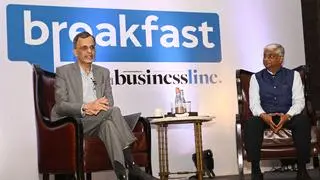The European debt turmoil may have caused rupee volatility and shaken investor sentiments in India, but real economy would be impacted only if the crisis prolongs for a longer period, says Dun and Bradstreet.
According to Dun and Bradstreet (D&B) Country Risk Update report, the debt crisis in the euro zone is a key threat to the global economy. With many EU banks highly exposed to risky assets, weaker credit conditions undermine growth prospects in the euro zone and beyond.
The two immediate repercussions of the euro zone debt crisis on India are: eroding investor sentiment, which is being reflected in the equity markets and volatility in the rupee (which has breached the psychological level of 50 per dollar), D&B Senior Economist Mr Arun Singh told PTI.
Mr Singh added, “the impact (of the euro zone debt crisis) on the real economy would depend on how protracted the debt crisis turns out to be.”
Amid the global economic turmoil world over, investors have become risk averse. As a result, the domestic equity markets have been witnessing considerable volatility as various facets of the debt crisis are unfolding each day.
The 30-share benchmark index Sensex has lost nearly 19 per cent from its all time high of 21,206.77 — scaled on January 10, 2008. Moreover, so far this year, the Sensex has lost over 16 per cent and was quoted at 17,192.82 points as on November 11.
The sovereign debt crisis in the euro zone, which started in late 2009, is assuming massive proportions. The concerns about the European Union’s ability to tackle it have fuelled fears that the region’s troubles would have ramifications over the health of global economy.
Owing to the movement of euro against the dollar, the rupee is witnessing extreme volatility, which in turn is affecting the export competitiveness of the country.
Rupee has fallen over 10 per cent so far this year and on November 11, the rupee closed at 50.12 a dollar.
Rupee volatility is also affecting monetary realisation of exporters and importers as they are struggling to manage their currency hedging. This scenario is expected to continue in the years ahead as well as rupee is expected to remain volatile in the near term, Singh said.
“Continued currency volatility could trigger an outbreak of ‘currency wars’ that could in turn presage ‘trade wars’
This would significantly increase risks for cross-border trade and investment, disrupting supply chains and threatening already-fragile profits,” the report said.
Until now, Indian exports have been growing robustly. The trend is expected to continue unless the debt crisis becomes more prolonged, considering that although India has managed to diversify its export destinations in recent years, Europe still accounts for more than 20 per cent of its exports.
During the April-October period, India’s trade deficit touched $93.7 billion, up from $72 billion in the corresponding period last fiscal.
Exports from SEZs in 2010-11 stood at Rs 3.15 lakh crore, an increase of 43 per cent over the same period last year.






Comments
Comments have to be in English, and in full sentences. They cannot be abusive or personal. Please abide by our community guidelines for posting your comments.
We have migrated to a new commenting platform. If you are already a registered user of TheHindu Businessline and logged in, you may continue to engage with our articles. If you do not have an account please register and login to post comments. Users can access their older comments by logging into their accounts on Vuukle.